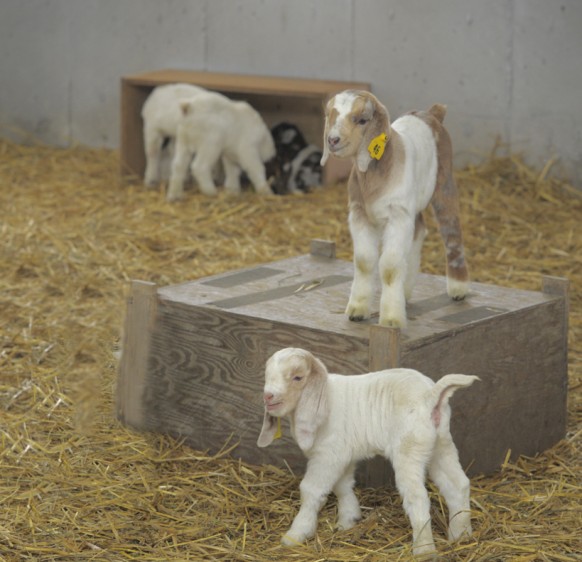Tips for getting your goat kids off to a healthy start
Click here for a PDF of this issue of the Goat Gazette.
 Ontario’s goat industry is growing, and with kidding season underway, every newly born goat is important. Good kid management is vital to provide your farm with a steady supply of healthy herd replacements – whether females for breeding or males for meat – and it’s in their early days that kids are the most vulnerable to sickness and death. Both male and female kids benefit equally from good health management.
Ontario’s goat industry is growing, and with kidding season underway, every newly born goat is important. Good kid management is vital to provide your farm with a steady supply of healthy herd replacements – whether females for breeding or males for meat – and it’s in their early days that kids are the most vulnerable to sickness and death. Both male and female kids benefit equally from good health management.
Health in early life stages plays a key role in an animal’s future production. If you’re experiencing mortality problems, get in touch with the Ontario Goat office – we’re here to help with resources and expert contacts.
Here are some key points to keep in mind when it comes to good kid management:
At birth:
 Ensure does give birth in a clean, dry and warm pen area with plenty of fresh bedding.
Ensure does give birth in a clean, dry and warm pen area with plenty of fresh bedding.- Disinfect the navel to reduce the risk of disease and monitor it for infection, as well as for drying and healing, during the first few days. Use a tincture of iodine (2.5 per cent) or chlorhexidine, not teat dip, to disinfect navels.
- Protect newborns from drafts and watch for signs of hypothermia.
- Individually identify each newborn and start production records.
- For dairy goat kids: separate them from their dam immediately and feed colostrum by bottle no later than six hours after birth. Each kid should be initially fed 50 mL per kilogram of body weight (bw) of colostrum, four times within the first 24 hours of life for a total of 200 mL/kg bw; the first feeding should be within an hour of birth.
- For meat goat kids: leave dam and offspring together in a bonding pen (a temporary pen inside the group pen) and if needed, encourage kids to nurse by moving them towards the udder.
Housing:
- Keep kids in a warm, well-ventilated area that is free of drafts. House dairy kids together in group pens and meat kids with their dams.
- Ensure bedding is dry and deep. Add more bedding daily and clean it out frequently to minimize disease risks.
- Kids should have easy access to feed and water.
- Don’t overcrowd. There should be enough space for all kids to lie down at the same time and enough room at feeders to reduce competition.
- Keep the air flowing. Good ventilation and clean air help keep kids healthy.
Feeding:
- Feed transition milk for three days after the colostrum feeding period – then switch to disease-free whole milk or milk replacers.
- To encourage rumen development, provide free-choice hay and a grain ration within the first week of life.
- Introduce any feeding regime changes gradually to avoid scours.
- Kids should always have access to clean, fresh water – keep it at room temperature and don’t let it freeze.
Health:
- Vaccinate kids at an early age to minimize disease. Consult with your herd veterinarian on proper doses, withdrawal times and correct administration.
- Common vaccines include Clostridium perfringens C and D (pulpy kidney) and tetani (tetanus).
- Separate buck kids from doelings at four months of age to prevent unintended breeding.
- If you’re removing horns, restrain the kid in a disbudding box. Use pain control, and follow directions for proper use of the disbudding tool. Disbudding should happen before kids reach three weeks of age.
For more information, consult Ontario Goat’s Kid management for commercial goat production: Kidding to weaning booklet or the Best Management Practices for Commercial Goat Production handbook, visit our resources page, or contact us.
